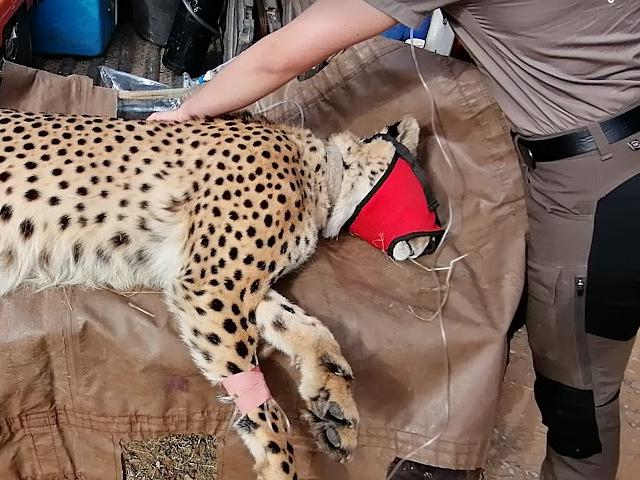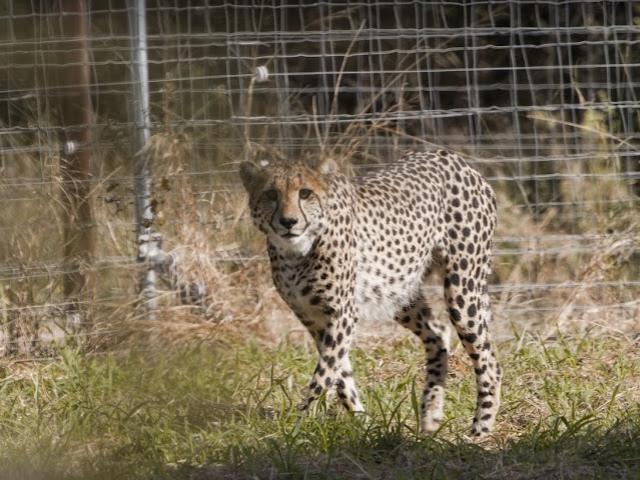Cheetah may be the fastest land animal but the project to introduce the spotted cat from Africa to India moved even faster. And the speed with which the Cheetah project progressed left many wildlife experts awed and intrigued. With a political push, Cheetah has defeated Lion and the latter may, perhaps, never ever be able to reach Kuno national park, originally planned as second home to Gujarat’s pride. Finally, India inked an MOU with Namibia in July and may sign another with South Africa soon. However, the travel plan of Cheetah from Namibia to Kuno is yet to be finalized. Experts have termed it “a vanity project”. Cheetah is likely to reach Kuno in the winters of 2022. However, thewildlifeindia.com carries exclusive images of the South African cheetahs to be translocated to India. Lion Loses Despite SC Order In Favour

Taking into consideration many factors including fear of an epidemic, the government of India in 1990s initiated a plan to find second home for Asiatic lions found only in Gir Naional park and Asiatic lion landscape (ALL) of Gujarat. Kuno Wildlife Sanctuary which was later accorded a status of national reserve was identified as an alternate home to the threatened species of the big cat. Wildlife experts believe that the lion population in Gir has low genetic diversity making it highly vulnerable to epidemic threats. They also cite the example of Canine Distemper, the disease that killed 1,000 East African lions in the Serengeti eco-region .The Centre for Cellular and Molecular Biology, Hyderabad has sequenced the entire genome of the Asiatic lion and it shows that lack genetic diversity in the ALL lions as compared to other lion populations and historical samples of Asiatic lion. Huge sum was spent in Kuno for the rehabilitation of villagers and other conservation works inside the jungle but Gujarat was always reluctant to share lion, considered as the its pride of the state.
Also read: Fate of Lion project unknown midst Cheetah translocation in Kuno
After years of litigation, the Supreme Court on April 15, 2013 ordered that, “we reiterate that while examining the necessity of a second home for the Asiatic lions, our approach should be eco centric and not anthropocentric and we must apply the species’ best interest standard, that is, the best interest of the Asiatic lions”. “We may indicate that our top priority is to protect the Asiatic lion, an endangered species and to provide a second home. The MOEF is therefore directed to take urgent steps for reintroduction of Asiatic lion from Gir forest to Kuno . The order be carried out in letter and spirit and within a period of six months from today”. Though Gujarat went ahead for a review petition and a curative petition, the apex court rejected both. Eight years after the court’s order, Kuno did not get a single lion. Nature lovers in the country wondered why the court’s ordered was not executed. Interestingly, a contempt petition was also filed which was rejected in 2018.Eminent wildlife biologist Dr Ravi Chellam termed the project as " an expensive mistake". Dr Chellam, also a conservation scientist explained ,"As a very expensive mistake which sets the wrong example for how conservation should be done in terms of prioritisation, by not following government policies and court orders, as well as not involving a wider set of people especially local communities in its planning and implementation. The unwillingness to listen to or engage with facts and well intentioned criticism is very worrying."
SC Reverses Its Order And The Haste To Select Kuno
The project to introduce cheetah was not new and was first floated in 2009. Though the project cheetah was lying dormant, it was alive in the government files. The Supreme Court order in 2013 had termed it “ arbitrary and illegal” .At this stage , in our view, the court had observed, the decision taken by the MOEF for the reintroduction of African Cheetah first and then Asiatic lion to Kuno is arbitrary and illegal. The order of the MOEF to reintroduced cheetah cannot stand in the eye of the law and the same is quashed. In January 2020, after an appeal filed by the National Tiger Conservation Authority (NTCA), the SC issued an order for the project to go forward as a pilot test, after suitable study and habitat selection.
“The same Union ministry of environment, forest and climate change and its officials who looked helpless in implementing the SC orders of translocation of lion in Kuno seemed to have worked overtime for cheetah reintroduction”, government sources claimed. In a period of 12 days, the field assessments of six sites were conducted, with some sites assessed for less than a day. Kuno was surveyed for the longest period of four days. “No wildlife scientist could justify this hasty approach. Apparently, the expert committee had already taken decision on Kuno even before the field survey and visit to jungle for introduction cheetah”. In the same speed, the clearance for the visits of the officials from African nation to Kuno and those from India to Namibia was completed followed by the signing of an MOU.
Cheetahs Qarantined In S. Africa

Before their extinction sometime around 1947, Asiatic cheetahs roamed most of India. Now only a very small population of about 20 Asiatic cheetahs survives in Iran leading to the plans of reintroduction of African cheetah to India from Namibia and South Africa. ”.Though India is yet to sign an MOU with South Africa, 12 cheetahs have earmarked for relocation project. Professor Adrian S.W. Tordiffe,Centre for Veterinary Wildlife Studies at University of Pretoria said , " an MoU is likely to be signed within the next dew days and the cheetahs may reach India by August 15".In an e-mail interview, he said, “The South African National Biodiversity Institute requested a population viability analysis (PVA) to determine how many cheetahs could be removed annually from the cheetah population in South Africa prior to approving the translocation to India. The 12 animals that will be moved this year is well below the maximum number determined by the PVA. If all goes to plan, we are hoping to have 12 cheetahs in India by the of August 15”. “The cheetahs earmarked for the India reintroduction come from various small private reserves in South Africa,” he said earlier in a media release. “They are currently in large quarantine camps at two facilities in South Africa and are being prepared for relocation to the initial reintroduction site in Kuno National Park in Madhya Pradesh,” he said.
Also read: Problem Of Plenty: Gir Lions Turn Scavengers As Deadly Virus Stares
Professor Tordiffe and Prof Leith Meyer, director of the Centre for Veterinary Wildlife Studies at UP, have been working with the Wildlife Institute of India and the Indian Tiger Conservation Authority on the relocation project since 2020, along with Vincent van der Merwe, who manages the cheetah meta population in South Africa and who sourced the 12 animals being prepared for their new home in the state of Madhya Pradesh. “Other closely related cheetahs in northwest Africa are also critically endangered. The only sizeable growing populations of cheetahs worldwide are from small private and state-owned reserves within South Africa. While there might be small genetic differences between the Southern African cheetah and the Asiatic cheetah, their function within an ecosystem is likely to be identical”, a Pretoria University spokesperson said.
Banner Image: Cheetah destined for India in quarantine boma north of Pretoria.
Cheetah in the quarantine boma - one of the animals going to India
Anaesthetised cheetah in quarantine boma for blood sampling, vaccination and fitting of a satellite collar
Images shared by Adrian S.W. Tordiffe





In this race the initial question has drowned. Which animal is more endangered in India? Whats the plan of the govt to save asiatic lions? The person who is working on this cheetah project is not the same person who was working for lions to provide them a scond home in palpur kuno? If cheetahs are coming to palpur kuno then what about lions? The money spent in palpur kuno to develop a habitat for lions then what happened to those plans on which the deptt worked for more than a decade? Is this cheetah prohject viable? Lets see how डिसेटरस this project will be for village cattles.
ReplyDeleteThanks for the insights. Nice, well researched blog.
ReplyDeleteA disaster or not, lets say we tried n introduced a big cat at Kuno for conservation n to increase or alter the gene pool (phenotypically) Why rely just on speculations n assumptions. Let nature takes its course from Kuno.
ReplyDelete